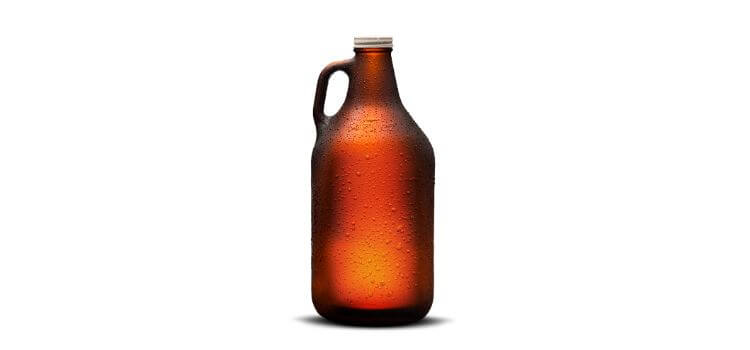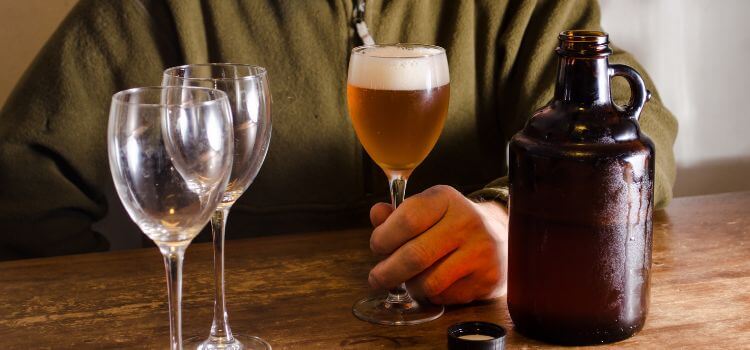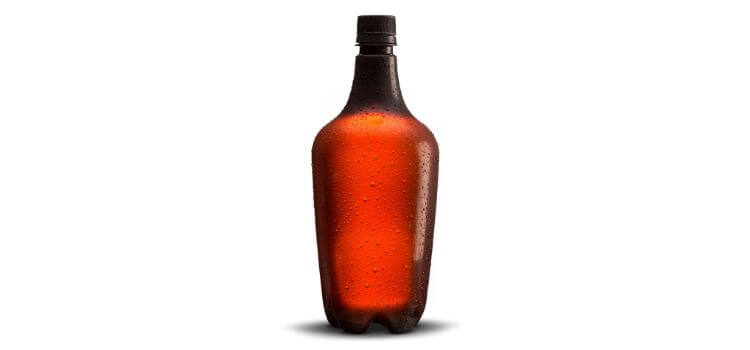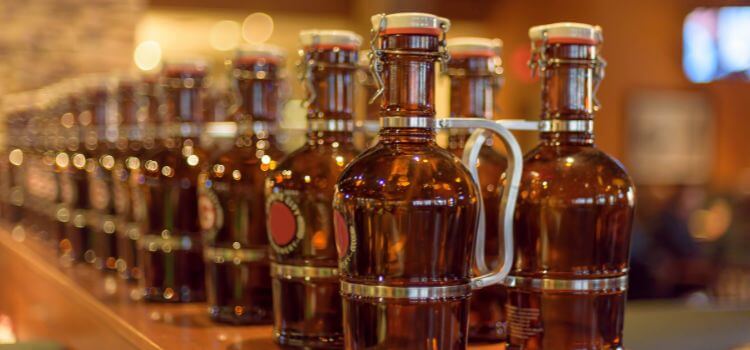As an Amazon Associate, I earn from qualifying purchases

Regarding the transport and storage of craft beer, opting for either a growler or a howler can greatly impact the preservation of freshness and flavor. In this exploration, we dive deep into the subtleties of these favored beer vessels, exploring their benefits and drawbacks to identify the optimal choice for savoring your favorite beers.
Join us as we navigate the world of beer vessels to help you make an informed decision for your next beer adventure.
What is a Growler?

A growler is a large, reusable container used to transport and store draft beer. Typically made of glass or stainless steel, it can hold anywhere from 32 ounces to two liters of liquid- equivalent to roughly four pints.
The origin of the name “growler” is uncertain, with several theories floating around. One popular belief is that it originated in the late 19th century when people would transport beer from their local taverns in small galvanized metal pails.
As they walked, the carbonation and movement of the liquid would create a rumbling or growling sound, hence the name “growler.” Others believe it comes from the sound made by the escaping CO2 when opening a bottle or jug of beer.
Types of growlers available in the market
Growlers come in a variety of shapes, sizes, and materials. The most popular types are:
- Glass Growlers: These are the classic and most common type of growler. They provide an unobstructed view of the beer inside and are usually dishwasher-safe. However, they can be prone to breaking or cracking if not handled with care.
- Stainless steel Growlers: These are more durable and can keep beer colder for longer periods. They also offer better insulation, making them great for outdoor activities or extended trips. However, they can be more costly than glass growlers.
- Ceramic or Clay Growlers: These are less common but provide excellent insulation and protection from sunlight, which can affect the beer’s flavor. However, they are more fragile and should be handled with care.
Pros and cons of using a growler
Pros:
- Reusability: Growlers are environmentally friendly and can be reused multiple times, reducing waste.
- Freshness: When sealed correctly, a growler can keep beer fresh for up to two weeks, depending on the type of beer and storage conditions.
- Cost-effective: Buying beer in bulk using a growler typically offers more value than purchasing separate bottles or cans.
- Variety: With a growler, you can sample different beers on tap without committing to a full pint.
Cons:
- Limited shelf life: Once opened, the beer in a growler should be consumed within 24-48 hours before it loses its freshness and carbonation.
- Sanitation: Growlers need to be thoroughly cleaned and sanitized after each use to prevent bacteria growth, which can affect the beer’s taste.
- Weight and portability: Filled growlers can be heavy and challenging to transport for long distances or outdoor activities.
What is a Howler?

A howler is a smaller version of the growler, typically holding about half the volume. They are also used for transporting and storing draft beer but are often more compact and easier to transport.
The origin of the name “howler” is also a bit of a mystery, with some theories suggesting it comes from the howling sound made by CO2 escaping when opening the bottle or jug. Others believe it’s related to the British term for 64 ounces, which is a “half-gallon,” and when cut in half, it becomes a howler.
Types of howlers available in the market
Like growlers, howlers also come in various shapes, sizes, and materials. The most common types include:
- Glass Howlers: These are smaller versions of glass growlers and offer the same benefits and drawbacks.
- Stainless steel Howlers: These are compact and durable options but can be more expensive than glass howlers.
Pros and cons of using a howler
Pros:
- Portability: Howlers are smaller and more compact than growlers, making them easier to transport for outdoor activities or short trips.
- Cost-effective: Like growlers, howlers can be a cost-effective way of purchasing and enjoying draft beer.
- Keeps beer fresh: When sealed correctly, a howler can preserve the freshness of beer for up to two weeks.
Cons:
- Limited quantity: Howlers can hold less beer than growlers, making them less ideal for sharing or longer trips.
- Sanitation: Like growlers, howlers also need to be cleaned and sanitized after each use to maintain the beer’s quality.
A Comparison: Growler vs Howler

- Capacity and portability: A growler’s larger size means it can hold more beer, making it ideal for sharing or longer trips. However, its bulkiness and weight make it less portable than a howler. On the other hand, a howler’s smaller size makes it easier to transport but limits its quantity capacity.
- Freshness and shelf-life: Both growlers and howlers, when properly sealed, can preserve beer’s freshness for up to two weeks. However, once opened, a howler’s smaller size may result in a faster loss of carbonation and freshness compared to a growler.
- Eco-friendliness and sustainability: Both growlers and howlers are environmentally friendly options as they can be reused multiple times, reducing waste from single-use beer containers.
- Cost and refilling: Depending on the type of beer and location, purchasing a growler or howler refill can be more cost-effective than buying individual bottles or cans. However, the initial investment in purchasing a growler or howler may vary based on the material and size chosen.
Choosing the Right Beer Container for You
Considerations Based on Personal Preferences and Usage:
- Frequency of use: If you plan to use a growler or howler frequently, investing in a more durable and long-lasting option may be worth it.
- Location and activities: Consider where and how you will be using the container. For outdoor activities or extended trips, a stainless steel option may be more suitable due to its durability and insulation properties.
- Beer preferences: Some beers, such as IPAs, may have a shorter shelf-life and lose their freshness faster than others, making a howler or growler less suitable for storing them for long periods.
- Budget: The cost of purchasing a growler or howler can vary based on the material and size chosen. Consider your budget and decide which option provides the best value for you.
Recommendations for different beer-drinking scenarios:
- At home: If you enjoy hosting small gatherings or trying different beers at home, a growler may be the best option, as it can hold more beer and is suitable for sharing.
- Outdoor activities: For camping trips or outdoor activities, a stainless steel howler may be more convenient due to its durability and insulation properties.
- Tasting different beers: If you enjoy tasting different beers without committing to a full pint, a howler may be the better choice as it allows for smaller quantities and easier portability.
Conclusion
Both growlers and howlers offer convenient and eco-friendly ways of enjoying a draft beer at home or on the go. Each option has its pros and cons, making it essential to consider personal preferences and usage when choosing the right beer container for you.
Whether you prefer the larger capacity of a growler or the compactness of a howler, both options provide an excellent alternative to single-use beer containers.
So, next time you visit your favorite brewery, consider bringing a growler or howler to enjoy a fresh draft beer in the comfort of your own home or on your next adventure! Cheers!
As an Amazon Associate, I earn from qualifying purchases